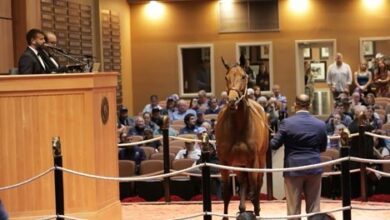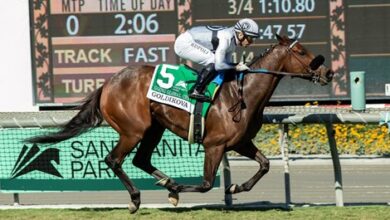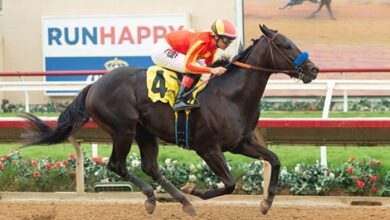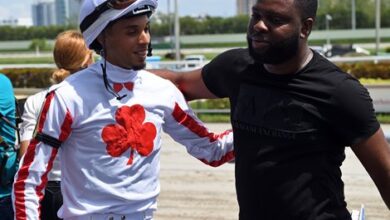Medina Spirit Death Spurs Heart Monitor Discussion
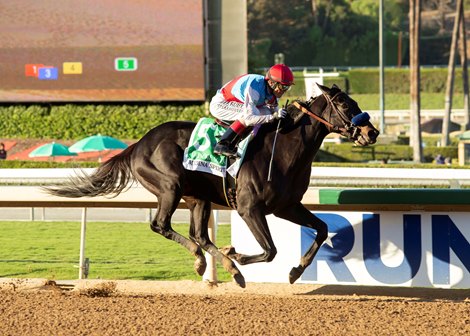
Death is never easy to accept in whatever form it takes.
Yet when it occurs suddenly, without warning, it adds shock and disbelief to the many overpowering emotions attached to it.
In horse racing, fatalities can happen to horses in an instant with one bad step. Yet there are also times when an equine athlete dies and there is no immediate answer for what happened.
In some of those, a heart issue can claim the life of a horse as suddenly and quickly as it does human beings.
“It’s called exercise-associated death,” said Dr. Scott Palmer, the New York State Gaming Commission’s equine medical director. “It is a truly catastrophic and shocking experience for everyone whether it occurs during racing or training. It shocks you to the core when it happens. It’s catastrophic for the owner and trainer who lose the horse.”
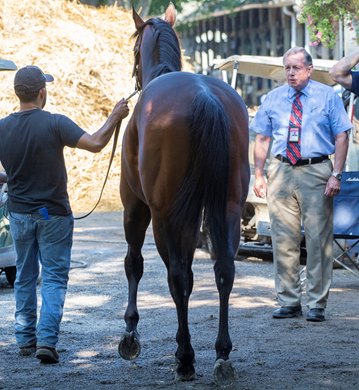
Dr. Scott Palmer observes a horse during a race-day inspection
Heart attacks account for only a small percentage of equine fatalities at racetracks. In New York during 2020-21, only 11 Thoroughbreds suffered fatal heart attacks, a number that is not surprising. Racehorses are young, physically fit animals, and their chances of heart failure increase as they reach an advanced age, much as it does with humans.
But those perceptions changed Dec. 6 when news broke that controversial Kentucky Derby Presented by Woodford Reserve (G1) winner Medina Spirit collapsed and died after a workout at Santa Anita Park.
The Feb. 11 release of a necropsy report on Medina Spirit by the California Horse Racing Board did not identify a definitive cause of his death, yet it reported there were some indications of a cardiac-related incident.
“The swollen lungs and foam in the trachea (windpipe), enlarged spleen, and congestion and mild hemorrhages in other tissues seen on the postmortem examination are common in horses dying suddenly, and are compatible with, but not specific for a cardiac cause of death,” the CHRB reported.
Since a necropsy in many instances cannot pinpoint heart failure as a cause of a death, the characteristics of Medina Spirit’s death at the very least raise some obvious questions.
Could a horse who turned in such a strong performance just a month earlier when he was second in the Nov. 6 Longines Breeders’ Cup Classic (G1) and was intensely scrutinized by veterinarians have a fatal heart issue? Were there warning signs?
Part of that answer involves how suddenly a heart issue can arise. Humans can undergo vigorous medical checks, pass them, and die an hour later. Horses are no different, as was the case in 1984 when Belmont Stakes (G1) winner Swale died eight days after winning the final leg of the Triple Crown, possibly from heart failure.
Another question centers on how Thoroughbred racing checks for heart ailments in its equine athletes.
Regardless of what actually killed Medina Spirit, be it an aneurysm, atrial fibrillation, or a completely different reason, his passing focused attention on an imbalance in the pre-race examinations of Thoroughbreds. While there’s a heavy focus on checks for banned medications and musculoskeletal problems, only minor attention is focused on the heart at a time when equine heart monitors are available.
The irony of the Medina Spirit situation is that after the Bob Baffert-trained 3-year-old failed a drug test following the 2021 Kentucky Derby, he became the center of intense scrutiny before his subsequent races, including the Preakness Stakes (G1) two weeks later. Yet the protocols for those races, including special procedures for him and other horses trained by Baffert, did not include a heart check.
Of the three Triple Crown races and the Breeders’ Cup, the only event that uses a heart monitor to check its starters before a race is the Belmont Stakes (a race Medina Spirit did not compete in). In New York, protocols put in place by the New York State Gaming Commission call for starters in all grade 1 stakes with a purse of $1 million or more, such as the Belmont Stakes Presented by NYRA Bets (G1), to receive an EKG (electrocardiogram) through a hand-held heart monitor.
“Checking the heart and using a heart monitor is something we need to make a priority in the industry and it’s always been a priority in New York with me,” Palmer said.
Yet for all of Palmer’s enthusiasm and belief in heart monitors, other medical experts believe they are ineffective when used on a horse during an at-rest stage, and can detect a serious issue in only rare instances. There is an EKG for horses during training that is more effective, but it has about a dozen leads that must be placed on the horse and its usage is considered to be problematic on a wide-scale basis.
“The average at-rest equine heart exam will not give you the answer you’re looking for. Even trained cardiologists cannot detect some problems from an at-rest exam,” said Dr. Dionne Benson, chief veterinary officer for The Stronach Group, who said she had encountered two equine heart attacks in the last three months after having none for two years. “We know a lot of the sudden deaths that are attributable to a specific cause are often associated with arrhythmias and you can’t detect the important ones at rest. We know they occur with exercise, just as they do with humans, and you have to see an EKG at that point in exercise to actually know what’s happening. Most of the major problems do not show up until it is too late. It is not as if I can stand next to a horse with a stethoscope and make a determination if it is safe or unsafe to race.
“With humans, you can use an exercise EKG and monitoring, but the problem with horses is that about 50% of horses have some abnormalities in their exercise EKG but you can’t say 50% have a heart issue. The key is to figure out how we can better identify horses at risk and right now we are limited in what we can do. With a hand-held EKG, there are going be some times when you can pick up something but there are going to be very few times when you can say the horse should or should not race.”
While there may be some disagreement on the effectiveness of certain methods, there is a strong consensus of opinion that more research is needed.
To that end, The Stronach Group has been working with the University of Minnesota since 2019 to study sudden death in Thoroughbreds, sending them samples from those deceased equines for research purposes. What has been learned in the last three years will be discussed March 20 at Churchill Downs when The Stronach Group will serve as a key sponsor of a cardiac session during the March 20-22 Racing Medication and Testing Consortium conference known as RegVet CE 2022. Those discussions in Louisville are expected to bring together more than 60 veterinarians from regulatory agencies.
“At the University of Minnesota they are looking for genetic risks in horses to see if there are certain genetic factors that we can test for and see if those horses are more likely to have a cardiovascular event,” Benson said. “We have been sending them samples of a horse who suffers a sudden death at our tracks and then we give them information about the cause of death because it could be a death associated with an aortic rupture or a large vessel rupture which is going to be different than the electrical irregularities and the arrhythmia associated fatalities. We are looking to see if there are any correlations in certain genetic patterns.
“The second thing they are doing,” she added, “is that they are trying to look at EKGs at rest and then EKGs of horses as they work to see which horses have abnormal EKGs during work that are concerning and then use artificial intelligence to go back and find the differences between the normal and at-risk horses since you can’t see it with the naked eye.”
In any analysis of the heart what stands out is how it is such an amazing organ that performs a mind-boggling task during every second of life.
As Palmer explains, the average Thoroughbred’s heart beats 30-40 times per second. Yet during exercise, that number could skyrocket to 240 beats per minute.
“That’s four heartbeats per second while they are racing,” Palmer said. “There’s also a complex series of coordinated events that has to take place during every single heartbeat. The electrical signal generated in the pacemaker of the heart travels down a conduction passageway into the large chamber in the bottom of the heart. The heart muscles contract and inject 65 to 75 gallons of blood per minute into the body. The empty chambers have to refill and the process is repeated four times in a second and that’s incredible.”
In dealing with equine hearts, Palmer said it is important to distinguish between two types of arrhythmia. Sinus arrhythmia, he said, is common in about 50% of horses and it disappears during exercise.
“Sinus arrhythmia is regularly irregular, and that may sound like a silly term but regularly irregular means the rhythm is irregular and it repeats itself in a regular pattern over and over again. That’s not a problem,” Palmer said.
Conversely, pathological arrhythmia may lead to atrial fibrillation, which can be deadly.
“Pathological arrhythmia is by contrast irregularly irregular, meaning the rhythm of the heartbeat changes all the time,” Palmer said. “The most common pathological is atrial fibrillation which can be asymptomatic in that the horse does not appear to be sick in any way or it can cause poor performance or it can cause sudden death during exercise. Atrial fibrillation is easily diagnosed by listening to a horse’s heart rate with a stethoscope or better yet by using an EKG app with a mobile phone. If a pathological arrhythmia is found, the horse will be scratched from a race and will be referred to a cardiologist for a thorough workup at a hospital.”
Palmer’s concerns led to the addition of the heart monitor check to the exams for all Thoroughbreds entered in $1 million or more races in New York. To date, he has yet to find a heart issue among those horses, but he has no regrets about taking the time and effort to do it.
“Honestly if I can do a single, rapid non-evasive procedure to rule out a pre-existing cardiac arrhythmia, I feel obligated to do so as a medical director. If I can save one horse’s life, it’s worth it,” Palmer said. “In the past eight years, I have examined every horse entered in a grade 1 race in New York with a purse of $1 million or more. This represents more than 200 well-condition elite athletes. In every one of them I find some degree of the sinus arrhythmia but I have yet to find one with atrial fibrillation or any other pathologic cardiac arrhythmia. So, that begs the question if we haven’t found any over the last eight years, why do we bother doing this? The answer is pretty simple. While an exercise-associated cardiac arrhythmia can happen even if the resting heart rate is normal the presence of an existing arrhythmia such as atrial fibrillation can put a horse at an increased risk of a cardiac event during high-speed exercise, and the bottom line is that if you don’t check for these arrhythmias, you will never find one.”
While the hand-held monitors are readily accessible, Palmer is one of the few persons involved with New York racing who uses them on a regular basis.
New York-based trainer John Kimmel is also a veterinarian, having graduated from the University of Pennsylvania’s School of Veterinary Medicine.
Early in his career, he used information about the size of Thoroughbreds’ hearts to pick out horses at sales, but after several years he stopped focusing on that because he was overlooking other important factors. Not helping was that he was told Thunder Gulch had a sprinter’s heart and that horse, who originally raced for Kimmel, was sold and became the winner of the 1995 Kentucky Derby (G1) and Belmont Stakes (G1).
Yet even with that background, Kimmel does not use the monitors and was not aware of any other New York trainer who uses them on a daily basis.
The reason stems from the paucity of equine heart issues Kimmel has encountered in a training career that dates back to 1985 and includes 8,320 starts with 1,394 wins.
“I’ve seen heart issues in a few horses and there’s no way to detect it,” Kimmel said. “You have to be extremely lucky. Only once I had a horse where I picked up an atrial fibrillation after a workout. He was fit and in good form but came back after an easy five-furlong breeze and he was blowing like he had never breezed before. I took out my stethoscope and he had atrial fibrillation. We saw it in an EKG and sent him to New Bolton for treatment.”
Who was that one? Friend Or Foe , a 2007 foal who recovered to become a stakes winner with earnings of $349,134.
In New York, monitors may not be the only way to reduce equine heart incidents.
According to Palmer, about two-thirds of the roughly 100 equine fatalities each year in New York are due to training or racing injuries and about 37% are due to exercise-associated sudden death. Of those numbers, in 2020 eight deaths were linked to heart issues. In 2021 that number dropped to just three.
“That’s an enormous change and it’s a very unusual thing,” Palmer said.
While Palmer cannot speak with certainty, he believes the drop may have been the result of recent restrictions on the use of thyroxine, a thyroid medication. Palmer said some trainers were using the drug to generate weight loss instead of its intended use to help horses with thyroid problems.
He added that thyroxine can raise a horse’s heart rate to a worrisome 300 beats per minute, leading to new regulations that allow the use of the drug only after testing and approval from Palmer.
“Thyroxine is used for treating hypothyroidism and young racehorses generally don’t have that. We recognized it was being used for weight loss and had an impact on performance while it added a lot of stress for a horse,” Palmer said. “We cut the exercise-associated cardiac deaths from eight to three since we implemented the new rule, and we will continue to monitor the results but I am very encouraged by the initial results with such a big drop.”
The CHRB passed a similar restriction on thyroxine in 2020.
The use of thyroxine first gained national attention in 2013 when a CHRB investigation into the sudden death of seven horses trained by Baffert in 2011-13 revealed all of his horses were being treated with the drug regardless of whether they had a thyroid issue.
Yet for the rare incidents of cardiac deaths in the sport, when a horse as well-known as Medina Spirit dies, it leads to a multitude of questions about preventative steps.
While Baffert did not respond to a question about whether or not Medina Spirit ever had a heart exam, it was not part of his pre-race exams as a 3-year-old.
“I looked at Medina Spirit several times but did not auscultate him (listen to his heart with a stethoscope),” Benson said. “It’s not something we usually do and if I auscultated him it would have been a one-time snapshot in time and very dangerous. If he has an AV (heart) block is that something he always has and should it prevent him from running? It’s a much easier question when a horse is lame.”
At the Preakness, after the news that an overage of betamethasone was detected in Medina Spirit’s urine after the Run for the Roses, Pimlico Race Course and Maryland Jockey Club officials announced Medina Spirit and Baffert’s other horses scheduled to run at Pimlico would receive additional drug testing, which revealed no signs of prohibited medications

Medina Spirit races to a third-place finish in the 2021 Preakness Stakes at Pimlico Race Course
Medina Spirit also received several medical checks during the week before the race as detailed in-depth by Dr. Elizabeth Daniel, the equine medical director for the Maryland Racing Commission.
“I get to Pimlico as early as Monday prior to the race and we may not inspect every Preakness starter every day but the Preakness horses get at least two exams prior to race day and then get a pre-race exam,” Daniel said.
“When Medina Spirit got to Pimlico we were in the immediate aftermath of the positive drug test and we did an out-of-competition drug test and sent it out immediately. That was through the racing commission. Dr. Benson drew separate samples the next day on Tuesday and they went to separate labs. Hers went to (the University of California Davis) and ours went to Industrial Laboratories in Colorado and both labs found no prohibited substances.
“Dr. Benson did ask for some X-rays of Medina Spirit. The Stronach Group had a surgeon who was there with us all week watching training as well and would assist in the exams. If we thought we needed an X-ray we would ask for one and the surgeon would go over those diagnostics with us. That has been the procedure the last few years.
“My exam is the same every day on every single horse. I listen to their jugular veins, I go over musculature of the back and hind end just to see if they seem sore. There’s a visual inspection in which we look for swelling or any wounds or scars. I palpate the front legs and I’m feeling for swelling or heat, anything that seems like a bony protuberance that we call that an exostosis.
“I will pick up the front left leg and go over the knee, checking it for a range of motion, feeling for heat or swelling or fusion in the joint. Then I’ll go down the leg, I’m palpitating the shin, the splint bones, the suspensory, both the deep and the superficial flexor tendons. I’m feeling all of those for any inconsistencies. Then I get to the ankles. I do the same thing, feeling for any swelling, anything that’s out of the ordinary. I will check the range of motion by flexing the joints and feeling the foot to make sure it doesn’t feel hot and look at the shoe to make sure there is not a special shoe or glue-on shoes, anything that’s different than a normal shoe. Then I move on to the other front leg and do the same procedure.”
Daniel, who did not have a heart monitor at her disposal, said Medina Spirit passed all of those tests prior to finishing third in the Preakness.
At the Breeders’ Cup at Del Mar in November, once again Baffert’s horses were a center of pre-race medical attention and there were new and enhanced safety protocols, including comprehensive pre-race testing that saw 166 samples from the Breeders’ Cup starters sent to UC Davis.
But there were no heart exams, an issue that was addressed by the Breeders’ Cup’s veterinary staff a few years earlier.
“Looking back, maybe in 2019 or 2018, we had a really serious discussion about doing cardiac exams on all participants at the Breeders’ Cup. We discussed it, there were some logistical issues and unfortunately, ultimately we did not do it for Breeders’ Cup. It was about the same time these new hand-held EKG machines were coming out and there was a lot of learning going on then,” said Dr. Will Farmer, equine medical director for Churchill Downs Inc. and co-lead of the veterinary team at the 2021 Breeders’ Cup.
Looking ahead, Breeders’ Cup officials say they are evaluating whether heart monitors will be used at future editions of the World Championships.
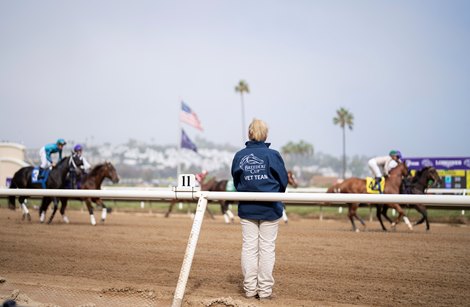
A vet looks on as horses canter to post at Del Mar for the 2021 Breeders’ Cup
“Breeders’ Cup puts the health and safety of its participants both equine and human first and foremost,” said Dora Delgado, Breeders’ Cup executive vice president and chief racing officer. “Breeders’ Cup has the most extensive safety protocols including: pre- and post-race testing, including out-of-competition testing for prohibited substances; comprehensive prohibitions on anabolic steroids and other controlled substances; a 24-hour equine security watch and periodic inspections and testing of all racing surfaces prior to the event.
“Additionally, the Breeders’ Cup veterinary team is comprised of 10-12 regulatory veterinarians from the U.S. and Europe which inspect runners throughout the two weeks leading up to the races. The company’s veterinary team joins the Host State Racing Commission Team in daily inspections of all runners both on track and in the shedrow. We are always looking to further advance safety including through new technologies and advancements. Breeders’ Cup routinely consults with its veterinarian team and we are continuing to evaluate the heart monitoring as part of the overall examination process.”
While there may still be much to learn about diagnosing heart ailments in horses, recent events have focused more attention on the issue, and Farmer believes that with the help of trained experts to review the data, heart checks can become a standard part of pre-race exams at major events.
“I think it could be done, but one of my concerns as a veterinarian who doesn’t routinely look at EKGs is that they can be daunting,” Farmer said. “There are squiggly lines and what does everything mean? Speaking just for myself, I can tell you what looks like a normal heart rhythm but I am not a cardiologist. My hope when we were discussing it a few years ago was that we could bring in a cardiologist to read them in or around Breeders’ Cup. I think there’s a lot that can be ascertained by simple auscultation, taking a stethoscope, and listening to a heart.
“You can hear if there’s an abnormal rhythm on auscultation that gives you a very cursory moment to pause and ask some questions before you proceed forward. I think there are opportunities. We just have to figure out how to incorporate that into our routine and our traditional pre-race program. But I wouldn’t be surprised if we start seeing more and more incorporating in the future.”
Additional reporting by Byron King.
